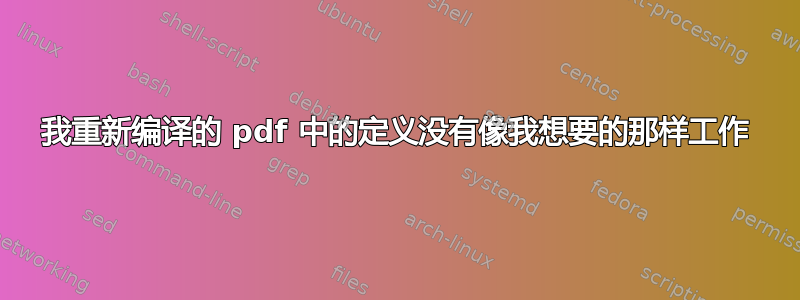
我很难理解清晰度的显示。参见下文,注意定义 A。
应该读定义。一个表达......我该怎么做:“应该读定义。一个表达式...”?我的尝试:我尝试用替换来修复它1在新的 a 字段中,但是当我重新编译它时,\definition 的参数是非法的。我最初尝试使用 \begin{definition}...\end{definition}。它说 \begin{definition} 是未定义的环境。

以下是源文件:
\documentclass{article}
\usepackage[margin=1in]{geometry}
\usepackage{amsmath,amsthm,amssymb}
\newcommand{\N}{\mathbb{N}}
\newcommand{\Z}{\mathbb{Z}}
\newcommand{\Q}{\mathbb{Q}}
\newcommand{\R}{\mathbb{R}}
\newcommand{\C}{\mathbb{C}}
\newenvironment{Theorem}[2][Theorem]{\begin{trivlist}
\item[\hskip \labelsep {\bfseries #1}\hskip \labelsep {\bfseries #2.}]}{\end{trivlist}}
\newenvironment{Lemma}[2][Lemma]{\begin{trivlist}
\item[\hskip \labelsep {\bfseries #1}\hskip \labelsep {\bfseries #2.}]}{\end{trivlist}}
\newenvironment{Reflection}[2][Reflection]{\begin{trivlist}
\item[\hskip \labelsep {\bfseries #1}\hskip \labelsep {\bfseries #2.}]}{\end{trivlist}}
\newenvironment{Proposition}[2][Proposition]{\begin{trivlist}
\item[\hskip \labelsep {\bfseries #1}\hskip \labelsep {\bfseries #2.}]}{\end{trivlist}}
\newenvironment{Corollary}[2][Corollary]{\begin{trivlist}
\item[\hskip \labelsep {\bfseries #1}\hskip \labelsep {\bfseries #2.}]}{\end{trivlist}}
\newenvironment{Definition}[2][Definition]{\begin{trivlist}
\item[\hskip \labelsep {\bfseries #1}\hskip \labelsep {\bfseries #2.}]}{\end{trivlist}}
\title{Videos script- Combining like terms}
\author{Carter Barker}
\date{March 2021}
\begin{document}
\maketitle
\section{Introduction}
In the next couple videos, we will review combining like terms and evaluating expressions, rules of exponents, and expanding and factoring polynomials before getting into solving equations and other algebraic ideas. In this video, we will talk about some basic terminology in mathematics before getting into the main point of the video, combining like terms. So I decided to split this video into two parts. First part is the terminology of expressions. The second part, we will use that terminology to combine like terms as well as evaluating some expressions.
\section{Terminology}
In every field, there are a set of vocabulary for every field, and mathematics is no different. Let's start with what is a mathematical expression:
\begin{Definition}
An expression is a...
\end{Definition}
\end{document}
答案1
您定义的definition是有一个可选参数和一个强制参数。我猜您调用是\begin{theorem}{1}为了生成一个数字,但显然您的定义没有数字。有了您的定义,TeX 将抓取定义文本中的第一个字母作为强制参数。
仅使用可选参数来定义它。
\newenvironment{Definition}[1][Definition]{\begin{trivlist}
\item[\hskip \labelsep {\bfseries #1.}]}{\end{trivlist}}
完整示例
\documentclass{article}
\usepackage[margin=1in]{geometry}
\usepackage{amsmath,amsthm,amssymb}
\newcommand{\N}{\mathbb{N}}
\newcommand{\Z}{\mathbb{Z}}
\newcommand{\Q}{\mathbb{Q}}
\newcommand{\R}{\mathbb{R}}
\newcommand{\C}{\mathbb{C}}
\newenvironment{Theorem}[2][Theorem]{\begin{trivlist}
\item[\hskip \labelsep {\bfseries #1}\hskip \labelsep {\bfseries #2.}]}{\end{trivlist}}
\newenvironment{Lemma}[2][Lemma]{\begin{trivlist}
\item[\hskip \labelsep {\bfseries #1}\hskip \labelsep {\bfseries #2.}]}{\end{trivlist}}
\newenvironment{Reflection}[2][Reflection]{\begin{trivlist}
\item[\hskip \labelsep {\bfseries #1}\hskip \labelsep {\bfseries #2.}]}{\end{trivlist}}
\newenvironment{Proposition}[2][Proposition]{\begin{trivlist}
\item[\hskip \labelsep {\bfseries #1}\hskip \labelsep {\bfseries #2.}]}{\end{trivlist}}
\newenvironment{Corollary}[2][Corollary]{\begin{trivlist}
\item[\hskip \labelsep {\bfseries #1}\hskip \labelsep {\bfseries #2.}]}{\end{trivlist}}
\newenvironment{Definition}[1][Definition]{\begin{trivlist}
\item[\hskip \labelsep {\bfseries #1.}]}{\end{trivlist}}
\title{Videos script- Combining like terms}
\author{Carter Barker}
\date{March 2021}
\begin{document}
\maketitle
\section{Introduction}
In the next couple videos, we will review combining like terms and evaluating expressions, rules of exponents, and expanding and factoring polynomials before getting into solving equations and other algebraic ideas. In this video, we will talk about some basic terminology in mathematics before getting into the main point of the video, combining like terms. So I decided to split this video into two parts. First part is the terminology of expressions. The second part, we will use that terminology to combine like terms as well as evaluating some expressions.
\section{Terminology}
In every field, there are a set of vocabulary for every field, and mathematics is no different. Let's start with what is a mathematical expression:
\begin{Definition}
An expression is a...
\end{Definition}
\begin{Theorem}{1}
A theorem
\end{Theorem}
\end{document}



